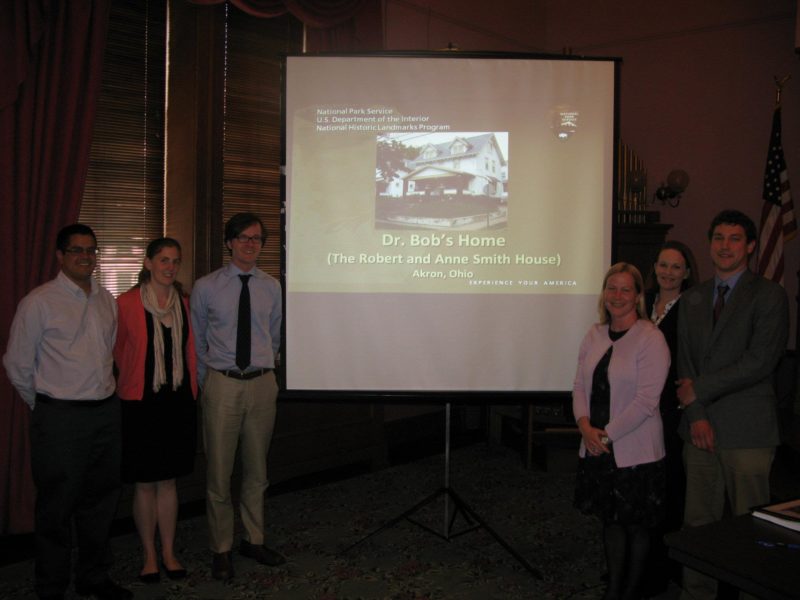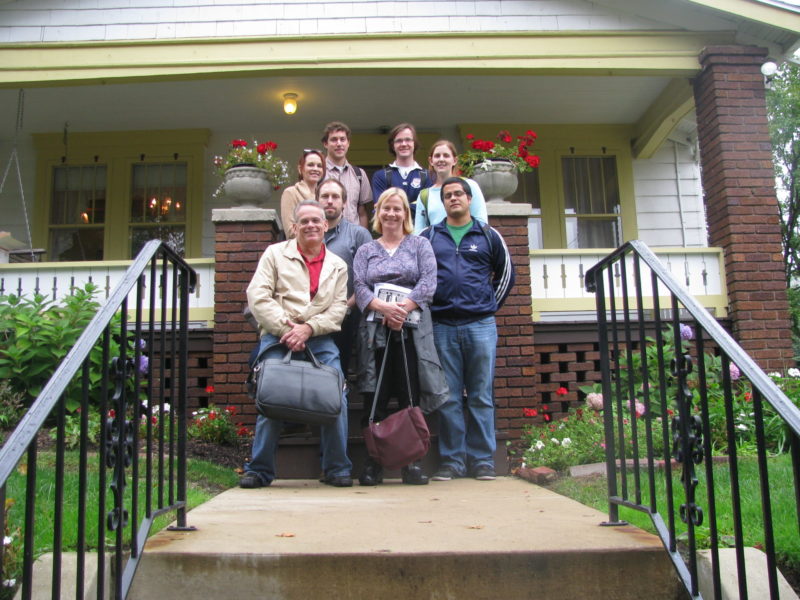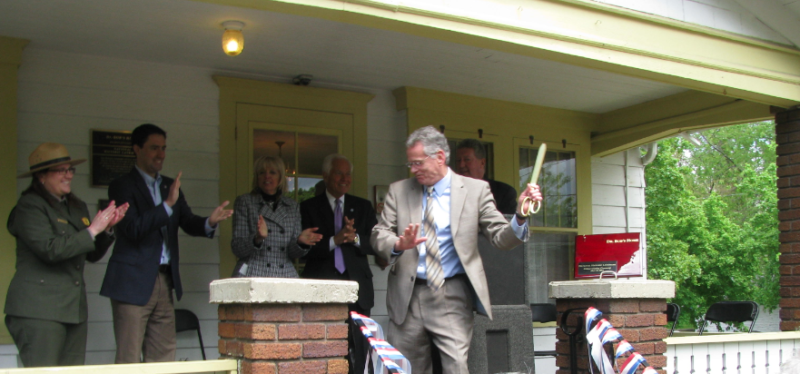Repairing National Register nominations: educational institutions and the National Register process
28 July 2020 – Michelle McClellan, Carolyn Barske Crawford and Leah Glaser
Authors’ Note: This is the third of three posts resulting from discussions of our 2019 NCPH annual meeting working group on improving existing National Register nominations. (The first post highlighted technical matters and the second discussed underrepresented communities and the integrity criterion.) In this series, we’ll highlight best practices we developed—using our working group member case statements as a starting point—to encourage frequent revisions of National Register nominations. We consider these thoughts a starting point in figuring out how to think of National Register nominations as living documents that must change periodically to reflect the history of a given community and serve its evolving needs. Join the conversation in the comments!
The students looked up in disbelief on the first day of class when Michelle closed the classroom door and said, “OK, today you are going to write a letter of intent to the National Park Service.” Rather than offering a leisurely syllabus review, she sketched out the process of writing a nomination for the National Historic Landmarks (NHL) program and put the students to work immediately on a letter of intent. Of course, she had been working with NHL staff for months before the class began, so she could guide the students with the knowledge that the letter would be well received by the NHL office. Over the course of the semester, the students researched and wrote an NHL nomination for the home of Dr. Robert and Anne Smith in Akron, Ohio, where Alcoholics Anonymous began. They traveled to Washington, D.C., to present their findings to the Landmarks Committee of the National Park Service and later returned to Akron to celebrate successful designation with community stakeholders.

Students and Michelle McClelland at the presentation of the nomination for the Dr. Bob and Anne Smith Home in Akron, Ohio, to Landmarks Committee, at the National Park Service. Photo credit: Kate Silbert
Partnerships like this one between educational institutions and the NPS or State Historic Preservation Offices (SHPO) can yield important dividends. Students get hands-on learning opportunities while state and federal preservation offices can benefit from new and updated nominations and amendments. The following suggestions can help lead to successful collaborations that avoid pitfalls.
Demonstrate that History is Interpretive and Ever-Changing
Nominations and amendments can demonstrate to students and community members alike that “history” is a dynamic process of interpretation. National Register nominations are living documents that can (and sometimes should) be amended because the meanings assigned to a building or landscape can change over time. While professional historians and preservationists take these ideas for granted, they can be deeply unsettling to many people.
History educators are ideal brokers in advancing a nuanced understanding of historical change and interpretation. Educators should have the skill set to step back, assess, and introduce these concepts gently to various audiences, whether community partners, property owners, or civic leaders. Students who have seen this modeled and understand the value and process of amending nominations will be well-served as they enter their own professional careers.
Build Consistent Relationships—Don’t Reinvent the Wheel
It’s important to build consistent communication and formalize processes and procedures between SHPO staff and educators so things do not have to be reinvented every semester or academic year. Colleges and universities are driven by the academic calendar. Students and even teachers may come and go every semester. This timetable does not necessarily mesh well with the rhythm and scheduling imperatives of the SHPO, property owners, or other community partners. Those who seek to develop partnerships should try to build ongoing relationships between SHPOs and educational institutions and to be realistic about the constraints of the academic calendar.

University of Michigan students and museum board member in front of the Dr. Bob and Anne Smith Home, Akron, Ohio, during the NHL designation ceremony. Photo credit: Kate Silbert
At some institutions, SHPO staff serve regularly as guest speakers in class and students go to the SHPO to intern. This helps relationships as well and makes SHPO staff invested. Students are more comfortable asking them questions and advice.
In fact, SHPO staff may well be graduates of local educational institutions and can help maintain the connection. For example, some SHPO staff members engage with students at their alma mater when in the area. When faculty members serve on review boards, they can take students to meetings so they can meet SHPO staff and learn about the NR process.
Remember that Small Steps Can Add Up
Even small projects or contributions to an ongoing initiative serve as important educational experiences for students and assist the work of the preservation office. Some faculty may conclude that if students cannot finish a nomination during a semester (a challenge even under the best of circumstances), then there is no point in trying to establish a partnership. But SHPO staff as well as more experienced faculty insist that collaboration can still be worthwhile. This is especially the case for amendments, which can be more complex and require greater creativity. Even contributing part of a project and making incremental progress can be valuable, helping students learn and demonstrating to community members new aspects of neighborhood history and raising awareness about preservation programs.
For example, NR amendments, context studies, mapping, and resource inventories will all help advance the work of the SHPO. In Alabama, for instance, the SHPO has stressed registering properties to the Alabama Register as a way to more easily engage students in the nomination process. This has resulted in some NR projects as well. The SHPO has also requested that the University of North Alabama work on updates in the region as needed. In one instance, a property (contributing) was left out of two districts—perhaps because each district assumed the property was included in the other. The property owner contacted the SHPO, who reached out to the university partner to update the district to include the building and to resurvey. A graduate student was able to take the lead on the project and the resulting nomination is much more complete and contains a much more nuanced description of the history of the district than the original nomination.
If you don’t already have a working relationship with your SHPO, consider asking them to put together a “wish list” of new nomination or amendment projects on which they would like assistance. Then educators could match those projects with undergraduate or graduate courses, independent study topics or student theses, summer projects, and mini-courses. In short, both sides have needs of varying scale and scope—and knowing more about the other’s needs and constraints can help promote collaboration that will yield real results.

Board members, National Park Service staff, and local dignitaries at ribbon cutting for the Dr. Bob and Anne Smith house. Photo credit: Kate Silbert
Leverage University or College Resources
Those seeking to develop partnerships with SHPOs should try to leverage the material and intellectual resources of the university. Students and faculty collaborating with the SHPO may have access to recording equipment, stable computer storage, tech support, and meeting space for oral history collection, for example.
The scholarly interests of faculty, library holdings, and any catalog of past student projects represent resources as well. These assets can help contextualize underrepresented time periods, groups, architectural types, and themes. The National Register program generally presumes that buildings must be fifty years old to be considered historic, a rule that has recently been debated and in any case is a moving target. For that reason, topics with considerable academic interest such as modernism, suburbanization, and affordable housing invite fresh perspectives to inform nominations.
Engaging Communities—Students as Ambassadors
Recent events across the United States focusing on statues and naming practices show that commemoration can be complicated and fraught, exposing fault lines in what communities value in the present by how they want to mark the past. National Register listings do not usually spark such dramatic reactions. Still, because they operate at the intersection of public memory, community identity, and property rights, preservation programs can be controversial in some locations. Residents may disagree on content—what kinds of events, people, or structures should be designated as historically significant—and on process, especially given that many people think the National Register imposes many more restrictions on property owners than it actually does. To address these misunderstandings and to foster dialogue around these issues, community outreach is very important. Colleges and universities often have the resources and training to carry out community engagement in ways that SHPO staff do not.
Community engagement is a growing focus at many schools. In some cases it is even a graduation requirement. Many colleges and universities are looking for ways for their students to become involved in the community, and they may therefore devote considerable resources to that goal, including staff time, project management, transportation, and other logistical support. Here too, an ongoing relationship can help the SHPO and the university beyond any one single nomination.
In many cases, students can gain entrée and establish community goodwill more easily than government workers or professional consultants. Because of the focus on education, community members seem much more interested in forming relationships. Outreach programs such as “History Harvests” can raise awareness of preservation programs and help the SHPO begin to document under-documented and under-represented groups and identify the types of resources important to the community—resources that might not be evident to those outside of the community. Community engagement programs can play an important role in helping initiate the nomination process, especially in areas where a framework of trust needs to be developed before a nomination is even begun.
Current public history students will encounter old nominations in their career, and they will likely work on amending and updating them. By forming collaborative relationships between SHPOs and educators, we can help provide students with the analytic, creative, and community engagement skills that can help make their future efforts a success.
~Michelle McClellan is the Johanna Meijer Magoon Principal Archivist at the Bentley Historical Society at the University of Michigan.
~Carolyn Barske-Crawford is the director of Muscle Shoals National Heritage Area and is on the faculty of the University of North Alabama.
~Leah Glaser is a professor and coordinator of the public history program at Central Connecticut State University.



